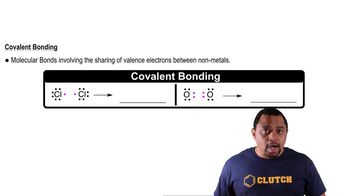Write Lewis structures for each molecule or ion. Use expanded octets as necessary. b. AsF6-
Ch.10 - Chemical Bonding I: The Lewis Model
Chapter 10, Problem 86
Which of the two compounds, H2NNH2 and HNNH, has the strongest nitrogen-nitrogen bond, and which has the shorter nitrogen-nitrogen bond.
 Verified step by step guidance
Verified step by step guidance1
Step 1: Identify the type of bonds in each compound. In H2NNH2, the nitrogen atoms are connected by a single bond. In HNNH, the nitrogen atoms are connected by a triple bond.
Step 2: Understand the relationship between bond strength and bond length. Generally, the stronger the bond, the shorter the bond length. This is because stronger bonds pull the atoms closer together.
Step 3: Apply this understanding to the compounds in question. The triple bond in HNNH is stronger than the single bond in H2NNH2, so HNNH has the stronger nitrogen-nitrogen bond.
Step 4: Similarly, because the bond in HNNH is stronger, it is also shorter. Therefore, HNNH has the shorter nitrogen-nitrogen bond.
Step 5: In conclusion, HNNH has both the stronger and the shorter nitrogen-nitrogen bond compared to H2NNH2.

Verified Solution
Video duration:
6mWas this helpful?
Key Concepts
Here are the essential concepts you must grasp in order to answer the question correctly.
Covalent Bonding
Covalent bonding occurs when two atoms share electrons to achieve a full outer shell, leading to the formation of molecules. The strength of a covalent bond is influenced by factors such as the number of shared electron pairs and the electronegativity of the atoms involved. In the case of nitrogen-nitrogen bonds, the presence of lone pairs and the overall molecular structure can significantly affect bond strength.
Recommended video:
Guided course

Chemical Bonds
Bond Length
Bond length is the distance between the nuclei of two bonded atoms. It is influenced by the size of the atoms and the type of bond formed. Generally, shorter bonds are stronger due to the increased overlap of atomic orbitals, which leads to a more stable interaction. In nitrogen compounds, variations in hybridization and steric effects can alter bond lengths.
Recommended video:
Guided course

Average Bond Order
Resonance Structures
Resonance structures are different ways of drawing a molecule that can represent the same arrangement of atoms but differ in the distribution of electrons. These structures help explain the delocalization of electrons in molecules, which can affect bond strength and length. In compounds like H2NNH2 and HNNH, resonance can influence the nitrogen-nitrogen bond characteristics, leading to variations in stability and bond properties.
Recommended video:
Guided course

Resonance Structures
Related Practice
Textbook Question
534
views
Textbook Question
Order these compounds in order of increasing carbon–carbon bond strength: HCCH, H2CCH2, H3CCH3.
1441
views
Textbook Question
Order these compounds in order of decreasing carbon–carbon bond length: HCCH, H2CCH2, H3CCH3.
1708
views
1
rank
Textbook Question
Hydrogenation reactions are used to add hydrogen across double bonds in hydrocarbons and other organic compounds. Use average bond energies to calculate ΔHrxn for the hydrogenation reaction. H2C=CH2(g) + H2(g) → H3C–CH3(g)
2668
views
1
rank
Textbook Question
Ethanol is a possible fuel. Use average bond energies to calculate ΔHrxn for the combustion of ethanol. CH3CH2OH(g) + 3 O2(g) → 2 CO2(g) + 3 H2O(g)
2906
views
Textbook Question
Ethane burns in air to form carbon dixode and water vapor.
2 H3C¬CH3( g) + 7 O2( g)¡4 CO2( g) + 6 H2O( g)
Use average bond energies to calculate ΔHrxn for the reaction.
